Fretting about sharks is natural if you’re planning on hitting any of Florida’s waterways. They’re apex predators with powerful jaws yet less than 10 people per year die from a fatal shark bite. Still, it’s best to know details about 15 of the sharks that live in and near South Florida’s coast and can be found along the coastlines of Miami Beach.
Some of the largest concentrations of sharks in the world are found in and near the Florida coast. Florida’s waters play host to them year-round though the types of sharks vary by season. Many shark species are highly migratory and most don’t stay in the same region for their entire lives.
Sharks sometimes use the Gulf Stream as a superhighway between distant places. The Gulf Stream is a strong current that sweeps halfway across the globe. Florida is right next to this important directional ocean current.
What are 15 of the sharks you might see in and around Florida and Miami Beach? We’ll look at some pictures and discuss a few details about them now.
15 Sharks in and Around Miami Beach
Here are 15 of the sharks you’ll find near Miami Beach:
- Lemon Shark
- Smooth Hammerhead Shark
- Dusky Shark
- Tiger Shark
- Whale Shark
- Silky Shark
- Great Hammerhead Shark
- Blacktip Shark
- Sandbar Shark
- Bull Shark
- Nurse Shark
- Bonnethead Shark
- Caribbean Reef Shark
- Scalloped Hammerhead Shark
- Atlantic Sharpnose Shark
Do Shark Attacks Happen in Miami Beach?
In 2020 and 2021 there were a combined four reported unprovoked shark attacks in South Florida. All were non-fatal. The most recent attack in Miami Beach happened in March 2021 when a 9-year-old boy was bitten by a shark on the shoulder. While the injury was serious, the boy was taken to a hospital and was in stable condition.
Looking back even further, Miami-Dade County (where Miami Beach is located) reports 19 shark attacks since 1882. That’s a far cry from Volusia County’s 337 reported attacks or Brevard County’s 155. In fact, Palm Beach County has reported more than four times the number of attacks Miami-Dade has reported, with 81 shark attacks.
This is to say while sharks can do live off the beaches of Miami Beach, shark bites have been extremely rare in its waters relative to the number of beach goers that get in the water.
1. Lemon Shark
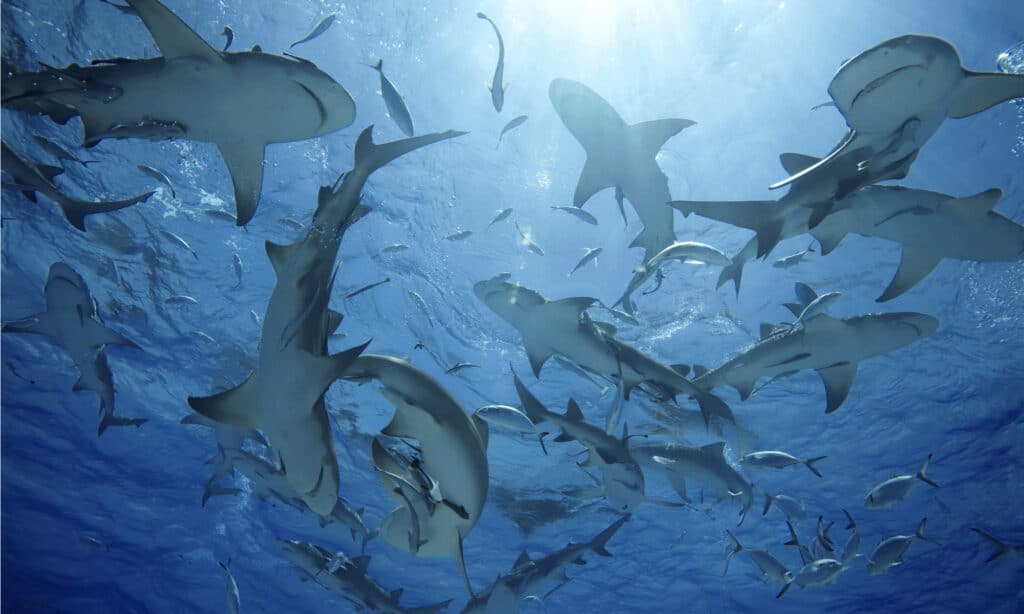
The most common shark near the Florida coast is the lemon shark.
©Yann hubert/Shutterstock.com
This is among the most common shark you’ll encounter off of the Florida coast. That’s because they like shallow water so they’re more accessible.
You’ll find them year-round though they’re most common from November through March. They weigh about 500 pounds and grow up to 7 feet in length, though the largest specimens can grow up to 12 feet. Lemon sharks are notable for entering a state of ‘tonic immobility’ when flipped on their back. That is to say, they play dead. So if you see a shark seemingly rise from the dead there’s no need to fear the rise of zombie sharks!
2. Smooth Hammerhead Shark
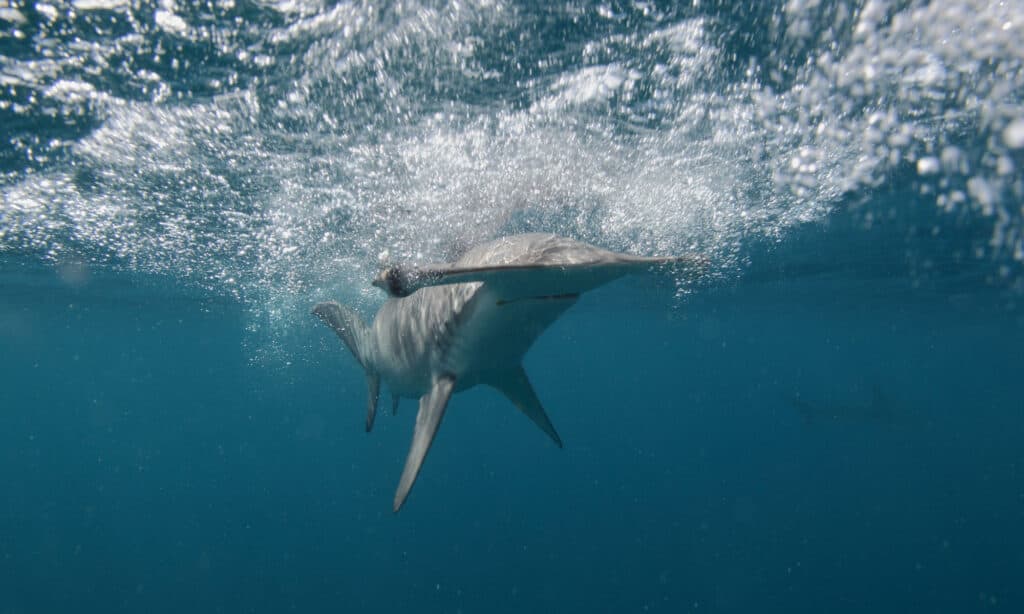
Smooth hammerheads are found from the Gulf Coast to norther Florida.
©Alessandro De Maddalena/Shutterstock.com
This is the second largest of the hammerheads in the world. Smooth hammerheads are often caught as by-catch.
The true range of this specific shark is still somewhat of a mystery. They are seen off of the Gulf Coast near Northern Florida though they’re usually found in the Atlantic Ocean. They are fond of the coast of South Florida outside of Miami Beach.
3. Dusky Shark
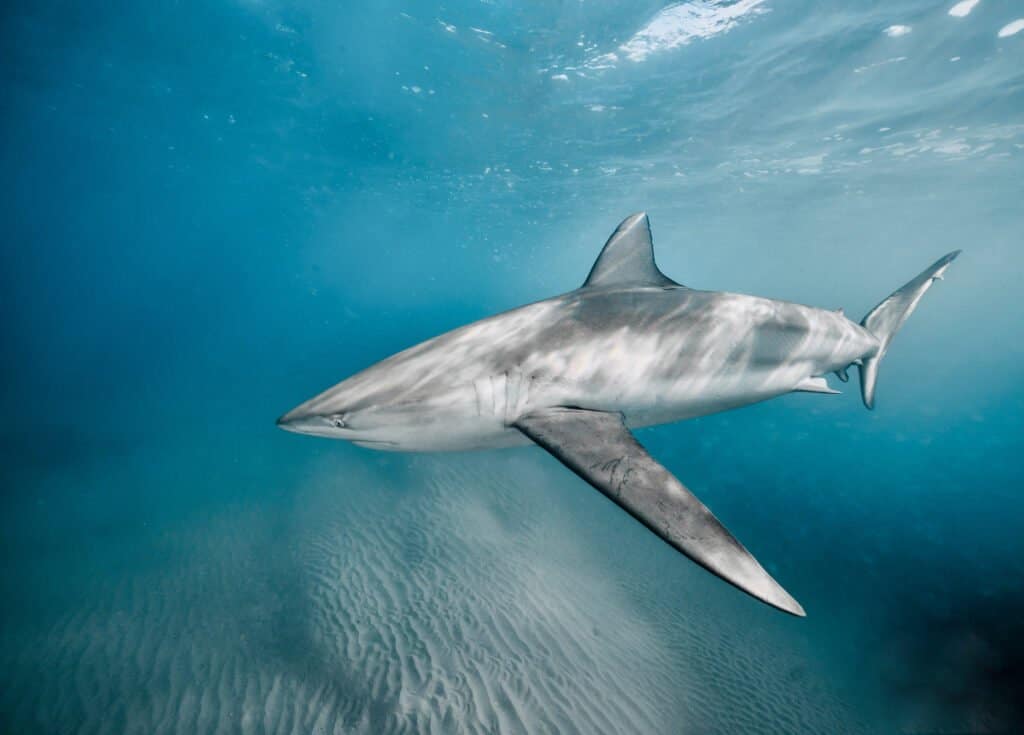
Dusky sharks stick near the coast of Florida.
©sirtravelalot/Shutterstock.com
Dusky sharks stick around the Florida coast from June to September. These are migratory sharks that hang out in both deep and shallow water near the bottom. They stick to temperate, tropical, and subtropical regions of the ocean.
They’re overfished, and as a consequence, they’re a vulnerable species. In the United States, fishing them is illegal. Their fins are prized in the shark fin trade.
They can grow up to 14 feet in length.
4. Tiger Shark
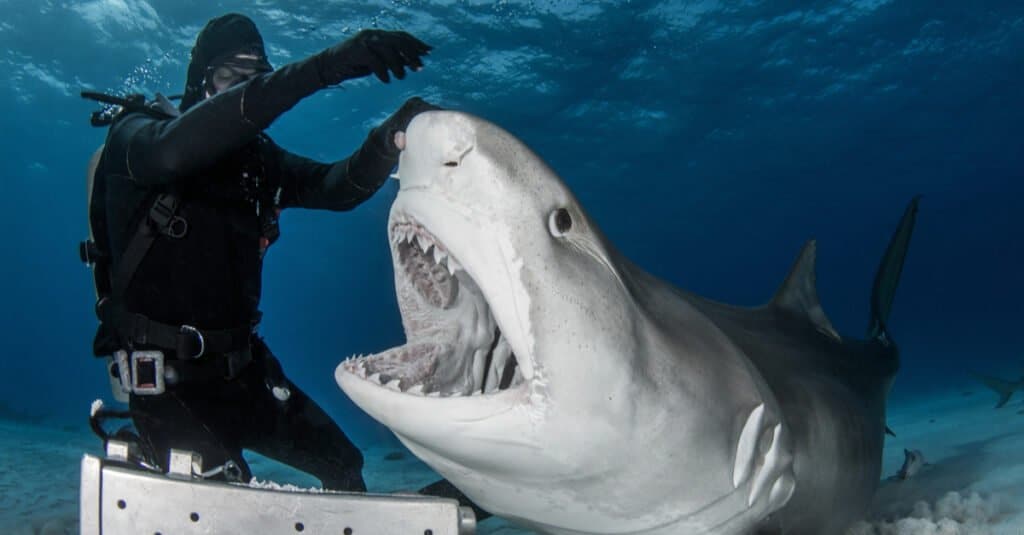
Tiger
sharks are the second-largest predatory fish in the world and the largest in tropical water.
©Tomas Kotouc/Shutterstock.com
Tiger sharks are curious and they’re huge. They are up to 18 feet long and can weigh nearly 2,000 lbs. As far as predatory fish go, tiger sharks are the second largest in the world.
They’re the largest predatory fish in tropical water though they are found in temperate zones as well. Tiger sharks are spotted from December to July. They’re extremely dangerous and human remains were found in the stomach of a tiger shark that was caught by fishermen near the coast of Florida.
They like to eat fish, reptiles, sea birds, and marine mammals. They’re opportunistic feeders and strange indigestible things have been found in their stomachs.
There have been sightings of them eating land birds as well. Some of the land birds they’re suspected of eating are hawks, American Coot, and turkey vultures.
5. Whale Shark
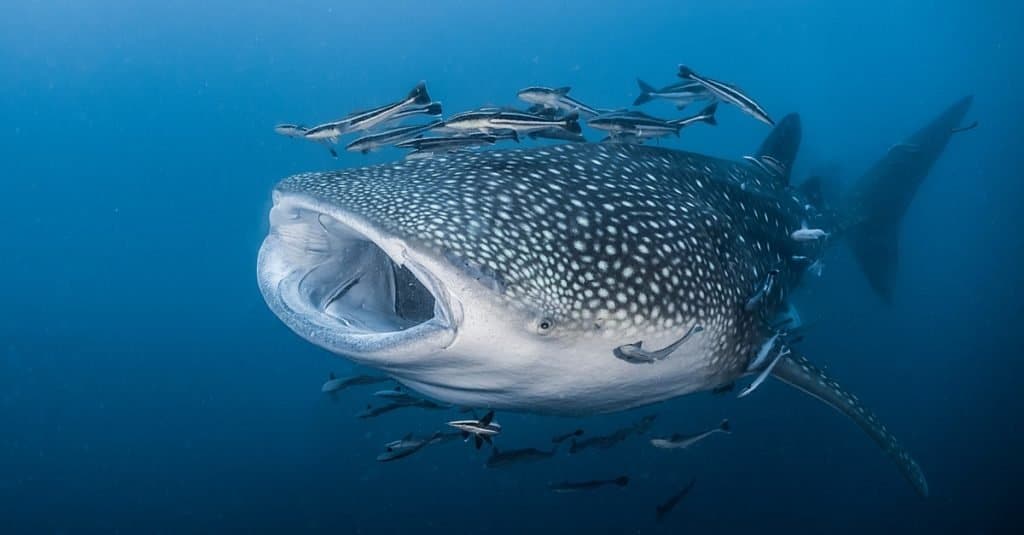
Whale sharks can grow to 60 feet in length.
©Onusa Putapitak/Shutterstock.com
These sharks migrate near the coast and have a wide range that they travel, both near Florida and not. They’re filter feeders that are usually spotted near the surface of the water.
Whale sharks are the largest fish in the ocean as they reach a whopping 60 feet in length. Because of their size and the fact that they’re filter feeders, they are dubbed “whale” sharks.
They’re an endangered species so conservation efforts are in place in some parts of the world. While no one has done a study on the total whale shark population in the world, it’s believed that their numbers are currently declining.
6. Silky Shark

Florida has a sustainable population of silky sharks off its coast.
©Shpatak/Shutterstock.com
This shark is often killed as by-catch, but Florida has a sustainable population off its coast. They are a vulnerable species because it takes them a long time to reproduce and their babies are dependent on adults for a good chunk of time.
These are deepwater sharks that rarely venture into areas that are less than 100 feet deep. They don’t generally pose a threat to humans because they don’t go into the environments that humans visit.
They like to eat tuna and other schooling fish which they probably sense with their extreme sensitivity to sounds.
7. Great Hammerhead Shark
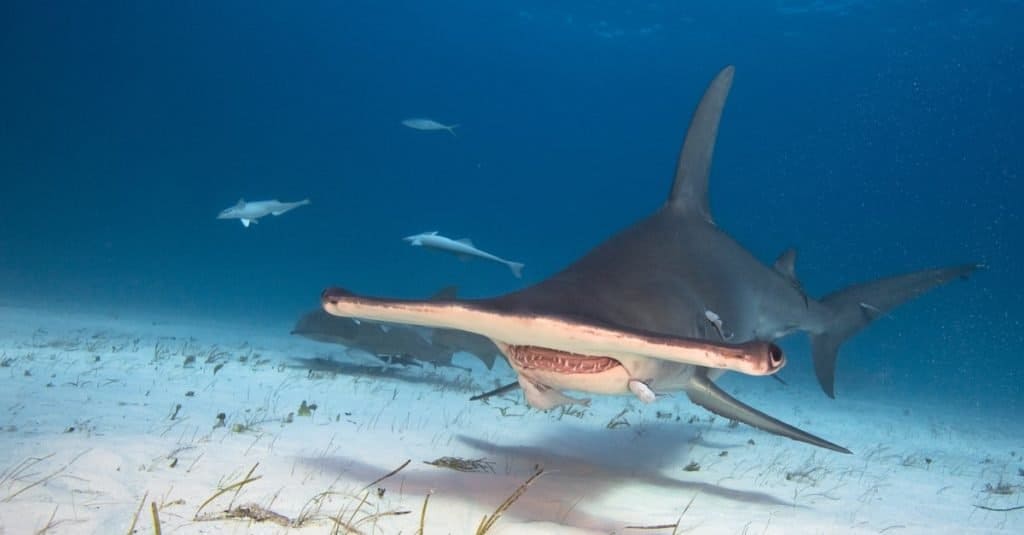
Florida is just one stop on a huge migratory journey for the great hammerhead shark.
©frantisekhojdysz/Shutterstock.com
These sharks are swimming in Florida’s waters from January to May. Florida is just one stop along a huge migration path that scientists are still trying to pin down.
They’re the largest hammerhead in the world. Great hammerhead sharks are huge and reach lengths up to 20 feet.
They’re not found in many places, but South Florida is one of the places where they’re spotted. They like coastal habitats as well as ocean shelves.
They’re a common by-catch and their fins are prized which is problematic. They’re not being caught in the same numbers as they have historically which may show that their population has significantly declined.
8. Blacktip Shark

Blacktip sharks like to spend their winters in southeast Florida.
©Gino Santa Maria/Shutterstock.com
In the summer months, these sharks hang out in the deep waters near the Florida coast. They come closer to shore in the winter. These sharks flee to shallow waters when they’re being pursued by bigger sharks like the great hammerhead.
They like to hunt around reefs and grow to be about 7 feet in length. They like to spend their winters near southeast Florida and they seek colder waters in the summer. They’re spotted along the coast of the Carolinas when they aren’t near Florida.
Blacktip sharks primarily eat little bony fish as is common on our list of 15 sharks in and near Miami Beach.
They’ve been observed moving into deeper water when a storm is approaching. Presumably, this is due to the drop in barometric pressure that happens before a storm hits. Other fish were observed behaving in the same way which is an interesting observation to scientists.
9. Sandbar Shark
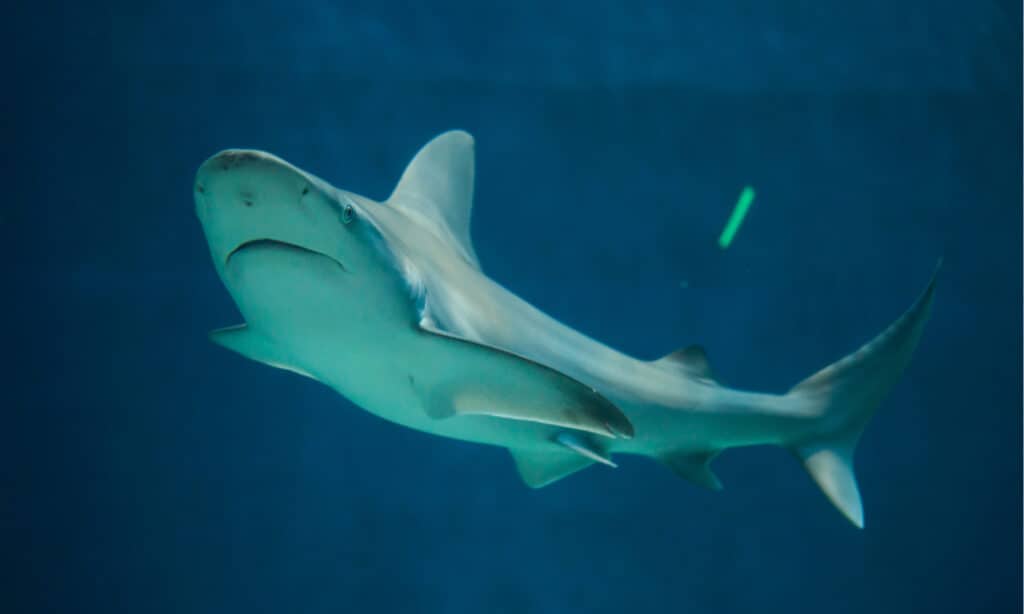
Sandbar sharks are considered safe when you’re swimming in Florida.
©Vladimir Wrangel/Shutterstock.com
They’re found along the Florida coast in both shallow and deep water. They usually cruise around in packs. These sharks hang out in harbors, estuaries, and bays as well as the ocean.
Sandbar sharks are one of the largest sharks that linger near the coast in the world. They can grow up to 8 feet long with males being a bit smaller.
They’re docile for a shark and they’re safe to swim near if you’re in the water on the Florida coast. No shark bites have been attributed to them. They’re popular in aquariums because of their temperament.
10. Bull Shark

Bull sharks are sometimes found in the creeks and marinas of Florida.
©Katja Tsvetkova/Shutterstock.com
The bull shark is one of the only shark that survives in freshwater habitats. They’re so comfortable with freshwater that they’re sometimes found in marinas, creeks, and other channels.
The reason they venture away from the ocean is to look for a suitable nursery. Bull sharks like lagoons with low salinity off the central east coast of Florida for breeding purposes. Young live there permanently while pregnant moms come to give birth.
They’re very aggressive and travel in packs. They grow to be up to 14 feet long and can weigh up to about 1,000 lbs. Bull sharks are primarily spotted at night during the spring and fall.
11. Nurse Shark

These sharks are near the coast of Florida all year. They use the area near Dry Tortugas near the Florida Keys as a nursery and a spot for mating. They hunt at night and rest during the day.
When they rest, they do so piled up in groups. Nurse sharks go back to the same place to rest every day like reefs and caves. They’re friendly and approachable when found in the shallows and they’re one of the most friendly sharks on our list of 15 sharks in or near Miami Beach.
These sharks are suction feeders and primarily prey on creatures on the seafloor. They especially enjoy spiny lobster, shrimp, sea urchins, crab, small fish, and squid. They hunt at night alone instead of in packs.
They’re overfished for their oil and skin, but conservation efforts have restored their populations.
12. Bonnethead Shark
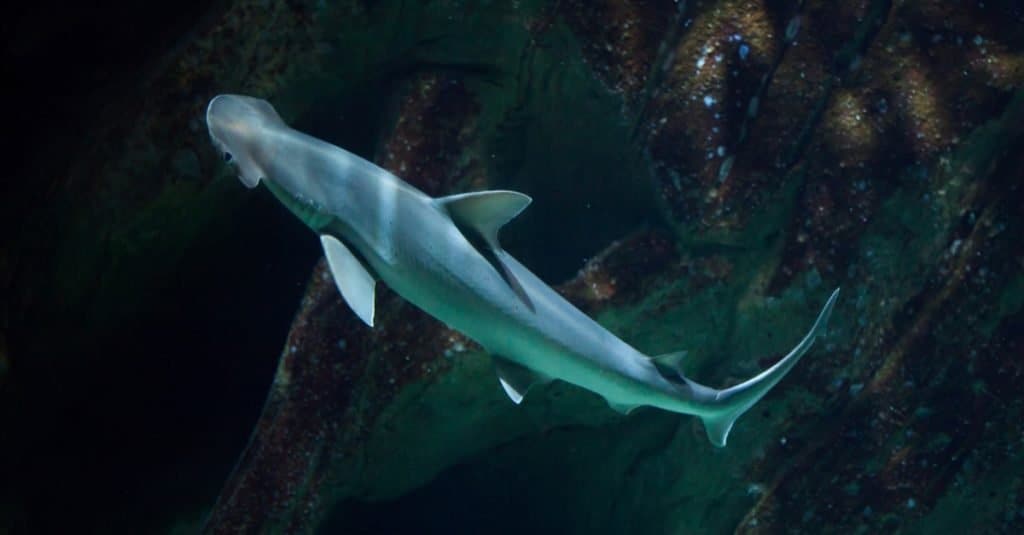
Bonnethead sharks are the only sharks that eat plants.
©Vladimir Wrangel/Shutterstock.com
This is the smallest of the hammerhead sharks and it’s the among the only sharks that’s known to eats plants (whale sharks have also been observed eating plants as a significant portion of their diet). These are schooling sharks that are usually seen in groups of up to 15 individuals.
Like a lot of the sharks on our list of 15 near Miami Beach, populations have declined dramatically. Bonnethead sharks are an endangered species.
Their diet consists of crustaceans and seagrass. They consume the seagrass to spare their stomachs from the injury that could be caused by the sharp shells of its primary food source.
13. Caribbean Reef Shark

Caribbean reef sharks are commonly seen near South Florida.
©Maui Topical Images/Shutterstock.com
These sharks like tropical waters around the globe and they’re commonly seen in South Florida. They grow up to 8 feet and weigh almost 600 pounds. They’ve been observed resting on the bottom of the ocean.
This shark is often confused with the silky shark and the dusky shark although there are slight differences in their coloration and the sizes of their fins.
These sharks are sometimes baited so they’ll approach tourists, but this has resulted in shark bites. It’s not recommended that you participate in an activity like this. If they’re just observed, they ignore humans.
14. Scalloped Hammerhead Shark

Scalloped hammerhead sharks are fast swimmers.
©Ian Scott/Shutterstock.com
These sharks used to be a lot more common but overfishing decimated them. Now they’re a rare sight. They’re only found in south Florida and they grow up to 10 feet in length. Females tend to be bigger than males.
Swimming fast is one of their specialties. They travel the world in tropical and warm temperate waters.
They like to use areas around Florida, like near Cape Canaveral, as a nursery. This has been a common theme amongst our 15 sharks in and near Miamia Beach.
15. Atlantic Sharpnose Shark
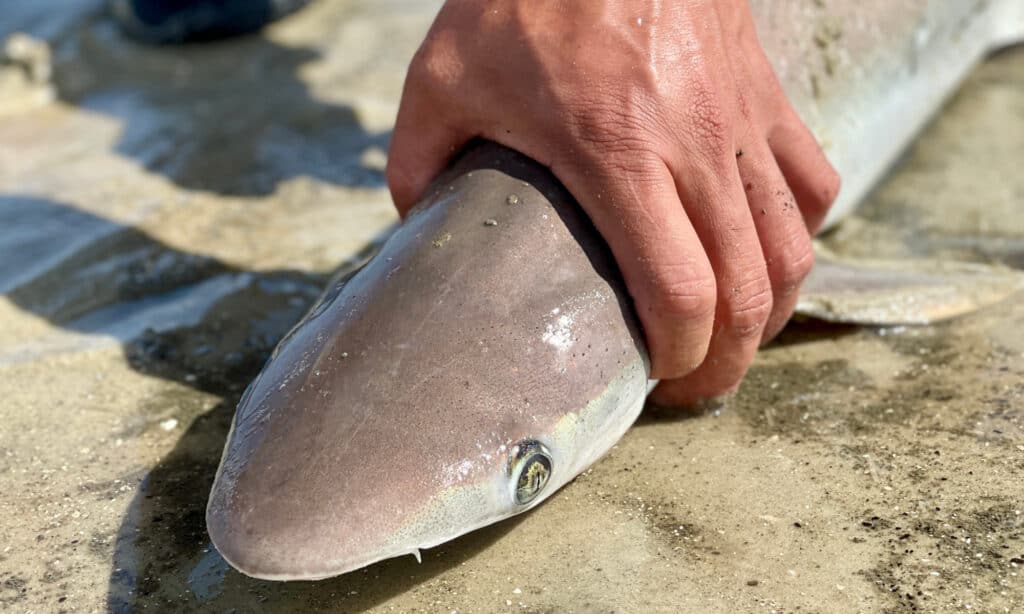
Atlantic sharpnose sharks are sustainably harvested for human consumption.
©Finley Del/Shutterstock.com
Atlantic sharpnose sharks are one of the most common sharks in the estuaries of northeast Florida. They seek out estuaries as nurseries and adults return to deeper waters once they’ve fulfilled their parenting duties.
This is a very small shark that’s available for human consumption. In the US, it’s considered a sustainable species and some laws guarantee that the sharks are responsibly harvested. They only grow to be almost 3 feet in length.
The photo featured at the top of this post is © Greg Amptman/Shutterstock.com
Thank you for reading! Have some feedback for us? Contact the AZ Animals editorial team.






